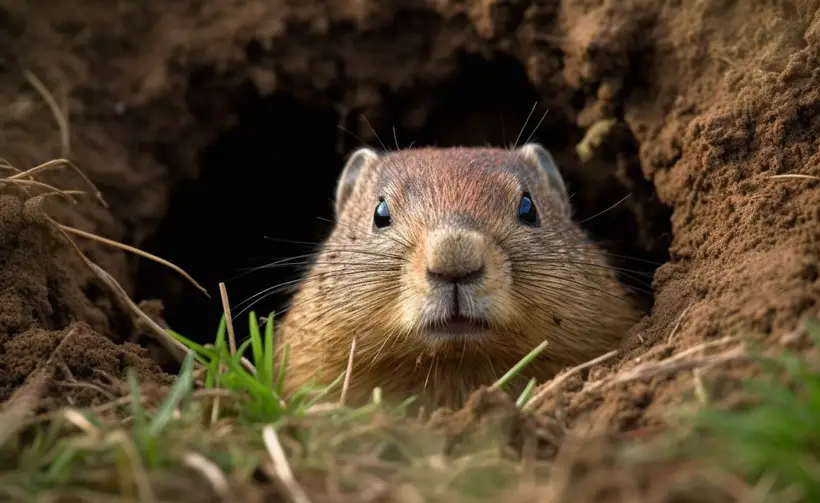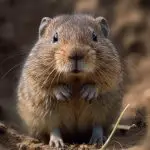Why Do Gophers Dig Holes?
Using poisons or natural pest repellents in gopher holes is common, but it doesn’t always guarantee the elimination of gophers. You may put the repellents in some holes, but gophers have a completely different way of moving across. During a gopher infestation on your property, they build a network of tunnels in various layers.
But why do gophers dig holes? The main reason behind gophers digging tunnels is to keep from predators. Snakes and coyotes are the most common predators for gophers. So, gophers create tunnels in such a way that they can reach food sources without completely getting out of the holes.
These tunnels have nesting, feeding, and storage areas. Gophers collect food from the surroundings and store them inside their tunnels. Their neighborhood can be stretched over several thousand square feet and about six feet deep.
When burrowing tunnels, they push the loose soil above the ground. It creates long mounds that are primary signs of gopher infestation on your property.
For successful lawn maintenance, you need to learn more about gopher hole patterns, gopher infestation timelines, and wildlife management strategies. This guide will give a detailed overview of the infestation, timeline, impact, and solutions. Let’s begin.
Anatomy of a Gopher Hole
Gopher holes are complex infrastructures underground that serve multiple purposes to gophers. For example, these holes are used as nesting burrows, food storage areas, drainage tunnels, waste holes, and feeding holes. Gophers have an amazing adaptive ability, which is evident in their short forelegs with large claws.

They can dig holes up to several feet deep using their claws. And the tunnels can cover an area of up to 2,000 square feet.
Their holes are divided into multiple sections. The holes you see on the ground are mostly lateral openings that they use to reach the main tunnel or runway. The main tunnel is usually 1 foot below the ground.
Gophers dig holes with their forelegs and push the loose soil above the ground using their hind legs. It creates soil mounds that can be a few feet in width and height.
The food storage is usually located at one end of the main tunnel. Gophers have cheek pouches to carry food from above the ground, and they store those food items in this storage. Another layer below the main tunnel is used as the nesting area.
They also use this area for mating. There are waste holes and drainage holes inside their tunnels. And feeding holes rise from the main tunnel so that gophers can collect food without exiting the hole.
The structure of their tunnels can change in winter. This is because gophers don’t hibernate and stay slightly less active during winter than in summer.
They tend to build additional layers below the existing tunnels to keep from the frosty soil. Depending on the soil quality, their tunnels can go up to six feet below the ground.
How to Identify Gopher Holes and Locate Gopher Activity?

Gopher holes can be easily located if you know the gopher burrowing behavior. They dig at an angle and push the loose soil above the ground. So, you will see fresh mounds of loose soil around the holes. These mounds usually look like crescent or horse-shoe.
The hole opening often has a dirt plug, which indicates gophers are active inside the hole and still burrowing.
Why Do Gophers Dig Holes?
Digging is a natural wildlife behavior in gophers or many other fossorial mammals. Gophers can move up to 2.25 tons of soil every year while burrowing. And they dig these holes for multiple reasons. Here is a detailed overview.

For Storing Food
As you might already know, gophers are herbivores. It means they depend on vegetation for feeding. They love tubers and the roots of different plants. But these sources may not be available all year round. So, gophers tend to collect food and store them inside their holes.
Also, gophers may not be as active in winter as in summer. In that case, they require a lot of food to overcome those chilly days. And when female gophers give birth to several litters, they need a lot of food.
To ensure food safety, gophers tend to store food in their tunnels. Gophers create separate storage areas adjacent to the main tunnels to store food.
For Protecting Themselves from Predators
The outer world can be perilous for gophers, especially when predators are around. Snakes, barn owls, coyotes, and other predators can hunt gophers down if they are on the ground for a long time.
Whenever gophers sense predators around, they retreat into the tunnels to hide from predators.
Even if the predators try to enter the tunnel network, gophers can confuse them with the maze they create. And they have the ability to block holes by pushing soil. So, the holes gophers dig keep them safe from predators.
For Thermoregulation
Gophers usually make their main tunnels 1 foot below the ground. But the place may become uncomfortable for gophers in the winter. They are adapted to use as less energy as possible in the winter.
When living in colder areas, they need to spend more energy to keep themselves comfortable.
This is why they dig deeper in winter to keep from the frosty ground level. Deeper burrows keep gophers comfortable and save their energy in winter.
Impact of Gopher Holes on Plants and Animals

Though the plant damage done by gophers is evident, gopher behavior can play an important role in the ecosystem. Here is how their holes impact other animals and plants.
- While burrowing, gophers aerate the soil, which increases water infiltration.
- Organic elements on the ground are mixed with the inner layers, which fertilize the soil to improve its quality.
- Gophers can provide habitat to other animals like, skunks, ground squirrels, and voles.
How Understanding Gopher Hole Patterns Can Help with Pest Control?
Many might assume that putting poison into the hole opening or leaving a snake can help in natural pest control. But it couldn’t be any further from the truth. And it isn’t among good wildlife management practices.
When you understand the structure of gopher holes, you can take preventive measures, such as installing barriers or garden fencing, laying traps, etc. So it becomes easier for you to reduce gopher infestation effectively.
Gopher Infestation Timeline
As gophers are active throughout the year, they can cause infestations in your lawn or garden at any time. But the most common infestation time is spring and fall. This is because the moisture level in the soil is just perfect in spring or fall for gophers to dig.

In summer, soil can be too hard for gophers to build their tunnel systems. During rain, the soil becomes too wet, which is also problematic for gophers to dig.
How to Identify Gopher Activity in Different Stages
You can identify gopher infestation by signs like large soil mounds here and there. If the soil mounds aren’t that high, it indicates gophers are still in the primary stage of infestation, and they didn’t dig too deep. So, it becomes easier to bait them or use predatory animals to reduce their population.
But if there are too many holes and high mounds, it means gophers have fully infested the area. And you need to adopt more effective pest control methods to eliminate the infestation.
Gopher Infestation Timeline
There are 13 gopher species in the United States, and they greatly impact plant growth. Here is a quick overview of the impact gopher holes have on plant growth.
Improved Soil Quality
When gophers dig tunnels, they help in aerating the soil. As a result, soil compactness gets reduced, which is helpful for many root vegetables. And the vegetation they collect in burrows gets mixed with the soil, which works as a natural fertilizer.

Better Water Distribution
Besides aerating the soil, gophers also mix minerals in different layers of soil. As a result, the ground can hold more water.
Increase Plant Growth
As the compactness reduces, it is easier for root vegetables to grow underground. But often, these roots are damaged by gophers. And you need to take measures to prevent root damage.
Understanding Hole Digging Patterns to Protect Lawns
A big part of lawn management is understanding gopher hole patterns. These patterns indicate where the feeding holes or nesting burrows are located. For example, if you see vertical holes near a plant, it should be a feeding hole.
Openings to main tunnels are made at an angle, which can help you implement pest control measures. When you lay a trap inside opening holes, it is easier to monitor gopher movement. And depth of the main tunnel can be measured using feeding holes. So, you can figure out the necessary depth for fencing.
Gopher Trapping and Removal Strategies
Numerous methods are followed to remove gopher infestations from your gardens or lawns. But not all of them might be effective in the same way.
- Natural pest control: Natural pest control methods include inviting predatory birds or animals into the garden, using natural pest repellents, companion planting, etc. For companion planting, you need to understand plant physiology first.

But these methods can be slow and not eliminate gopher infestation completely.
- Live gopher trap: Live gopher traps can be a good way of removing gophers from your garden. In this method, you need to set up gopher traps with baits inside the hole opening.
When gophers are caught in the trap, you need to carefully relocate the gophers a few hundred meters away from your property. This can help you in reducing the gopher population in the garden.
- Lethal trap: Lethal traps can help you remove gopher infestation effectively. You can use baits to attract gophers to the traps and they will die because of the sudden shock from the metal blade or clamp.
How Identifying Gopher Holes Help in Trapping and Removal?
If you figure out gophers are still in the primary stage of infestation, you can use natural pest repellents or baits to allure them out of the holes. And when predatory birds attack gophers, they won’t have that much space to hide.
But when the holes are deep, you need to use live or lethal traps to catch or kill these garden pests.

FAQs
Check answers to some commonly asked questions about the burrowing behavior of gophers.
What do gopher holes look like?
Gopher holes have multiple layers underground. The first level is considered the main tunnel. Opening holes dug at an angle reaches this tunnel from the ground. Drainage holes, feeding holes, and storage areas are located at this level. Nesting burrows are located beneath this level.
What should I do if I suspect a gopher infestation?
If you see signs of gopher infestation, you can use natural or chemical pest repellents to drive gophers away. Using traps or predatory birds can also help.
Can gopher holes be changed based on weather conditions?
Yes, Gophers usually live one to two feet below the ground. But they can dig up to six feet in winter to keep from the freezing weather conditions.
Conclusion
Gophers can easily sense the soil composition to determine where to build their tunnel systems. They usually avoid soils that are too dry or too wet. Moderate moisture content with good porosity makes a perfect ground for gophers to dig.
Their natural behavior is to dig holes where they store food. They also protect themselves from predators and maintain a comfortable temperature in burrows.
While making burrows, they push soil above the ground that makes mounds. Gophers can make up to four mounds per day, which may indicate the status of gopher infestation in your garden.
And understanding the infestation stage is crucial for effective pest control. When the infestation isn’t that severe, you can use more eco-friendly methods for garden pest control. But if the gopher population is too high, you must take stricter steps to prevent plant damage.
You should further research the burrowing behavior of gophers and natural pest control methods to keep gopher infestations at bay.




